This interview I did with Nicola Wood was both eye opening, humorous at times and moving. In particular the heart-felt recollection she shared with me at the end of my interview with her.
I was pleased to see that you also do abstract art because a lot of the artists I interview focus solely on fine automotive art.
That was the way I began. I studied textile, wall paper design and pattern making because I was a girl. When I went to art college at 15, I wanted to go into the painting school. I didn't know very much about fashion and textile but I was a girl and did what I was told. I was put into fashion and then I discovered that textiles were more expressive, colour wise and shape wise. So I switched over to textile design and had a full career in that.
There are a lot of horizontal and vertical designs in your abstract art. Is there a relation in that?
No not at all. When I was at the Royal College of Art in London, I discovered a book called 'Art since 1900. Then the abstract expressionists started to come onto the scene in America and my textile art designs were very much like that. Half of them were realistic flowers and another part of them, which were very successful with a company called HEAL'S in London, were of these abstracts. I am not doing abstracts today, there is no time. I got involved with the cars and the cars take up all my time. The paintings are so detailed.
'Vibration' Textile Designs by Nicola Wood
Were the fabrics that you were designing being used for clothing or for interior?
Mainly for interior and furnishing fabrics. In fact one of my abstracts called Vibration which was sold to HEAL'S, sold 8.5 miles in the first two months. I think that was some kind of a record. You can still buy it on ebay. Little pieces that people are selling, like 3 yards here and 6 yards there.
I still have a sample myself. Then I worked for a German company called RASCH which is a wallpaper company. I was under an exclusive contract with them doing their wallpapers and it was wonderful.
I have years of wonderful association with them and their family.
A lot of artists would be envious at what you accomplished at that time already.
I was successful and I was lucky. It was wonderful and I did a little teaching as well, encouraged by RASCH. I just wanted to design full time and they wanted me to keep in with what was going on, which you do when you are in a college situation. You are always up to date.
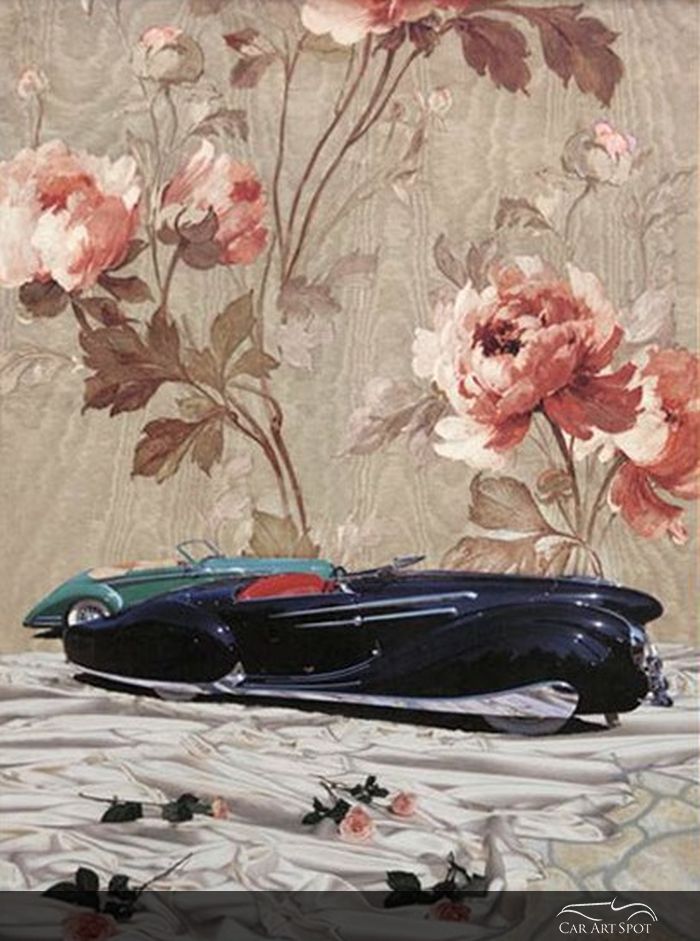
Nicola Wood incorporates her textile design experience
with automotive art in 'Two Delahayes with Flowers'
Were you teaching at college for art or fashion?
I was teaching textile design which covers patterns of any nature for dresses, carpets, tiles, furnishing fabrics, you name it. Anything which has a pattern on it. I also taught in Wormwood Scrubs Mens' Prison. It was like a kind of 'giving back' teaching because all the men are in there for life. It was different from teaching 18 year olds. These guys were stuck in prison for years and years. I thought I could turn them all into artists at that time and some of them were pretty good.
Did you stop with the educational part of your work when you moved to the US?
When I moved here, I stopped teaching but I was still working for RASCH. I would fly over to London and then to Germany and communicate even without computers. I would go over there and talk about the collections and the fashion. Then I would come back to either London or Los Angeles, do the designs and then send them to Germany and it worked out beautifully.
Is there a relationship between the design of fabrics and paintings? I can imagine with fabrics you are limited to production methods. Is there a cross over between the both?
No there isn't. I had always wanted to paint but the college I went to didn't want female painters. They were only interested in male painters. In fact I was mortified because the professor at the Royal College of Art in London told me it was pointless teaching women because all they do is get married and have babies. I was surprised he said that but it made me more determined. If anyone tells me I can't do something, I do it and I do it better than anybody else, because I get angry . He had a nerve to say that to me especially when I had a piece of fabric on the market of 8.5 miles.
Did you go back to show him?
No, I didn't. I got a full bright scholarship and a travel scholarship from the Royal College of Art to go to Parsons School of Design in New York. There they didn't have a textile department, so I was automatically doing illustration and colour theory and classic design. It was wonderful and I didn't want to leave New York. I was living in Greenwich Village but I had to make some money. The scholarship money was only for a year or two, at the most. So I started designing book jackets and selling them. One of my first book jackets was The Night of The Iguana by Tennessee Williams. I would go to the book publishers and the advertising agencies and was getting work right, left and centre.
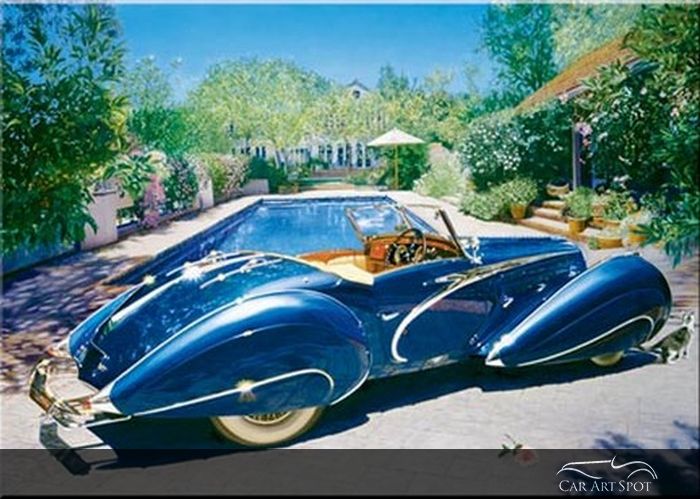
Blue Delahaye by Nicola Wood
When did you start painting cars?
I had to go back to London, UK and I hadn't yet got to the point where I was desperate to paint in oils. That happened after I came back to America and an acquaintance of mine died rather young. I told myself that I only have one life and if I wanted to paint, I had to do it now before it was too late. That was a crucial moment. So I took three years off from my textiles and lived from my savings to see if I could paint in oils. I had an incredible education in the art schools learning composition, anatomy, perspective, figure drawing, costume life drawing, everything but I was never trained in oils. They changed it several years later and made it much more abstract for students coming out of school who were not able to draw. I was lucky to have had that training and was at the art school for nine years.
So despite what your teacher at the Royal College of Arts said to you, this was an even bigger revelation for you.
Right. A lot of people end up dying with regrets wishing they had done this or that. I didn't want that to happen to me. I wanted to do what had been denied me. First of all I thought I would paint flowers because I was really good at doing that with my textiles and wallpapers. I actually started one. I was living in an apartment at the time here in Los Angeles and I looked out of the window and saw a big black 59 Cadillac. I had never seen one before. Your life is what you notice and when I saw the Cadillac, I went downstairs and photographed it. Then I did an airbrushed painting of it because that is how I was going to do the flowers and it came out wonderful.
Were you surprised that it turned out so beautiful?
Yes. I then found another 59 white Cadillac because the first one I did just on paper. So I went out and bought a canvas and some oil paints etc and painted this white Cadillac. It was just amazing to me to wake up every morning and go and see what I had done the previous day and watch the chrome become chrome and watch it become real. It was very exciting.
Was that also the first time you were creating such realistic artwork?
Yes, because of my training, I was always able to draw realistically. We were drawing live nudes when I was 15 and 16. You learn how to see things and how light plays with objects etc.
So that is how you started painting cars?
Yes, it was kind of accidental. I wanted to paint and the first thing I saw that I wanted to paint, happened to be a 1959 Cadillac. I didn't think anybody else was painting automobiles and I had never seen anything quite as extraordinary as a 1959 Cadillac. English cars are very sophisticated and didn't have the pizzazz that a Cadillac has.
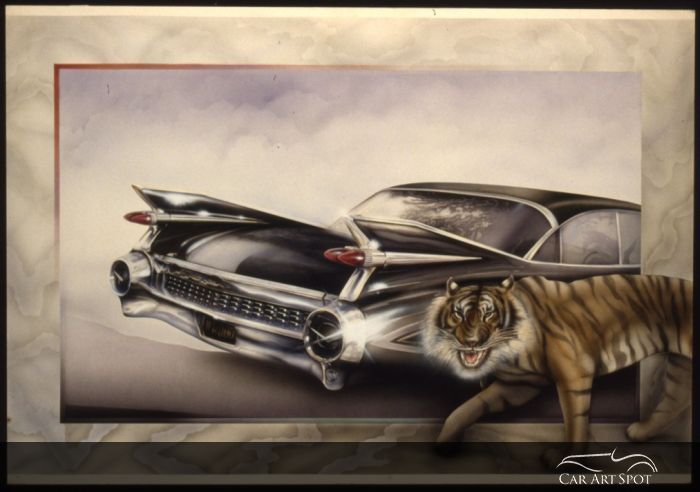
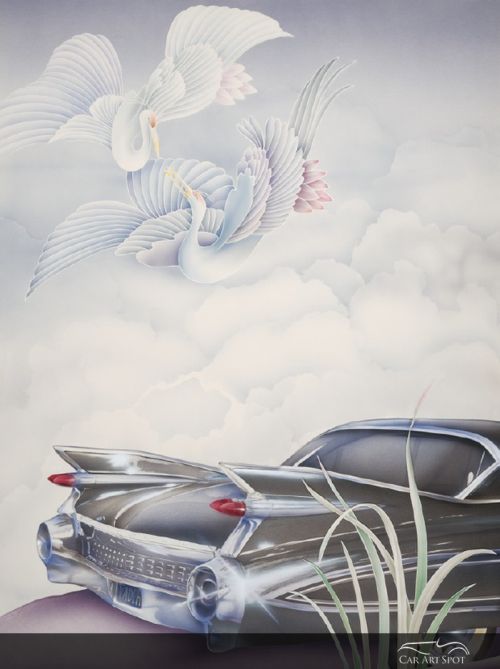
'59 Black Cadillac by Nicola Wood
Did the flowers make it into that painting as well?
Yes, part of one of my textiles ended up in the first airbrushed painting which I did. I did two of the black 59 Cadillac and I put flowers and Japanese birds in the sky in one of them. I put a tiger laying down next to the Cadillac in the other one. I never just paint the car.
I noticed that a lot of your paintings seem to express enjoying life, freedom, beautiful skies. Does it reflect on how you live your life Nicola?
Yes, in a theatrical way. I like objects to be moveable. I guess I don't like stationery stuff. In my back yard, I buy all this white satin and drape it up and take photographs. So I make these stage sets to go with the paintings.
The white satin is something which comes back in a lot of your work as well.
Yes, Delahaye and Death Valley. That car had to be on a sand dune because it looks like a red sand dune itself. It's got that beautiful sensual body.
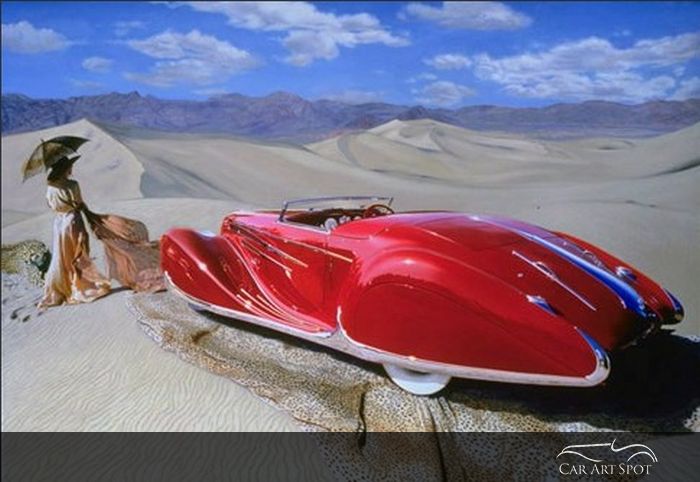
Delahaye in Death Valley by Automotive Fine Arts Artist Nicole Wood
What triggered me with that painting is that the car itself stands on the leopard
That is my bed sheet. I actually went through Death Valley to find the sand dunes. I took a friend with me and dressed up in that 1930s gown and climbed 800 feet in high heels. Death Valley has its' name for a reason, so we were there at 6 a.m. in the morning. I climbed 800 feet up these enormous sand dunes. Beautiful, incredible. I got my friend to take photos of me and I took photos of the dunes and then I put them altogether and added that leopard which is one of my favourite felines.
I notice the leopard on the left. Is it just because you like that animal or is there a deeper meaning to it?
I have always loved animals generally, but leopards in particular. I have leopard sheets, carpets, leopard clothes, coats, a coat for my little white poodle. He loves to trot around in his little leopard coat.
You like to dress him up that way?
Well I dress a lot in leopard and quite often we are dressed identically. It is not a self conscious thing. I have been collecting leopard stuff since I was in my 20's.
You painted a 60's Chevy which also has the white satin which is almost flying over it. It reminds me of a painting done by Salvador Daly. He uses a lot of satin as well.
You will have to tell me which one that is because I know Salvador Daly's work but I've never associated myself with his work. The style of that painting was unique to me. I love the tactile qualities of satin, fur, petal and metal. They all have their own quality and I like the sensuality of that.
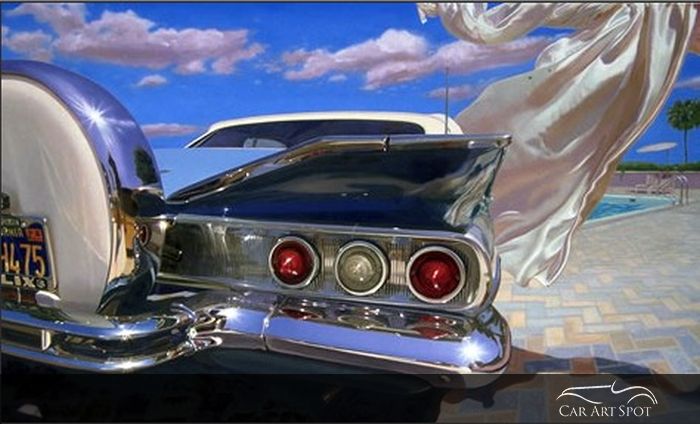
60's Chevy by AFAS Artist Nicola Wood
It also comes back in your painting of Red Hot, where it's almost transparent and you see the ocean through the satin.
We went to the beach and we took the fabric. We made a big curtain and hung the fabric on so I could see how it would all look.
So you put a lot of time in the preparation.
Yes, I don't knock these things off. Nicola laughs.
Can you tell me a bit about the preparation and the work that goes into the artwork before you start painting.
I am very spontaneous. I do most of everything in my head. Like the 59 Cadillac I did, I put two giant lipsticks which were in chrome cases next to it and I think there is a piece of fabric in it as well. I actually didn't think these lipsticks would look like the rear lights of a 59 Cadillac I only realized afterwards what I had done because it just sort of happened. I didn't do hundreds of drawings to arrive at that. I never do.
So does it happen while you are working on the painting, or while you are sketching beforehand?
No I usually start with the car and I take all my own photographs. If I get a really good photograph like I did with the 60s Chevy and the 59 Cadillac, it kind of speaks to me and it becomes obvious what has to go with it. To me. Something which compliments it, makes it look better.
Is the car reflected in the lipstick? I can imagine the difficult part is putting several elements into one painting and getting the lighting and reflection right.
Well I don't think I got the lighting. I didn't even think about that at the time. There was no reflection in the car of the lipsticks. Unless you can see them? Nicola laughs.
I used separate photographs and drawings which I put together. Those lipsticks were an advertisement in a Vogue magazine. So I ripped them out and added the next thing which went with them to compliment them.
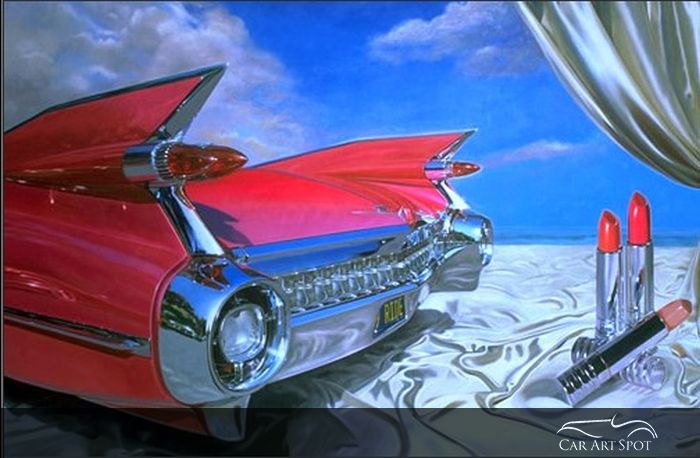
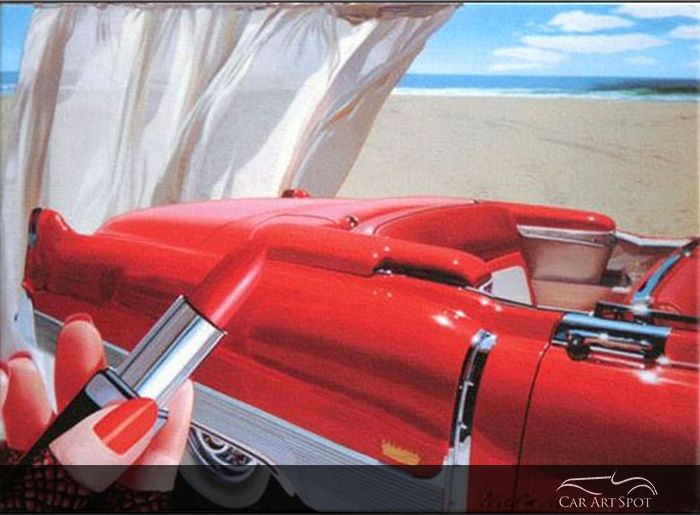
Red Hot by Artist Nicola Wood
Do you have a whole collection of torn out magazine adverts for inspiration, for whenever that moment comes?
Yes, but I seem to be able to remember them. I am one of those awful people who sits in a doctors' office and rips photo's or adverts out of a magazine of say a swimming pool or something else and puts it in my pocket to remind me of a fabulous composition. Then I go out and find my own swimming pool and take a photograph of it, so that the thing is more or less mine.
Does it mean that you also have a bucket list of things you still want to paint?
Oh yes. I am never going to live long enough. The longer I live the more ideas I accumulate. Every day I come up with paintings that I want to paint. I have decided at this point that I am going to do what I don't normally do. I am going to paint a whole bunch of water coloured sketches of my ideas for future paintings and then just use the most complete compositions.
Composition and colour is so important. I don't call my paintings automobile paintings. They are like a magic realism. They don't exist in a photograph. Nobody else can do what I can do. A photograph would never be the same as how I can paint it. Also with the composition and lighting etc.
I paint art that women like as well as men.
So you don't consider yourself as an automotive artist but rather an artist who happens to paint cars.
Yes, that's right.
A lot of the artists I speak to seem to be stuck in a class of automotive art. They consider themselves to be general artists but they have difficulties escaping that niche. Are you facing that same dilemma?
No, I think the road I am going down is totally different from any other automotive artist that I have ever come across. When I started painting cars, I had no idea that there were other people painting cars out there, who were also all guys. When I was in my two year sabbatical period of painting, it was wonderful. I was painting every day, not spending any money on anything and didn't have many responsibilities. I had already kicked out my shopping cart for when I became homeless because I didn't care. I had to paint and once I got into the class thing, it just grew and grew.
At one point I was living in San Francisco and a girlfriend took me to Stanford University where there was a car show held in a field. There was a man there with a table full of car drawings. I went up to him and told him that I paint cars too. He and a handful of other guys had just started the Automotive Fine Arts Society (AFAS). This was auspicious that I should meet the president of that little beginning society in a field. He told me to go to 'Road on Track' and see Bill Motto the art director because he was also one of the artists starting AFAS. I came back to LA and I drove down there with my paintings and they invited me to show with them at Pebble Beach Concours D'Elegance, which was small then. There were not that many artists but it was the beginning of a big career change for me, by doing that.
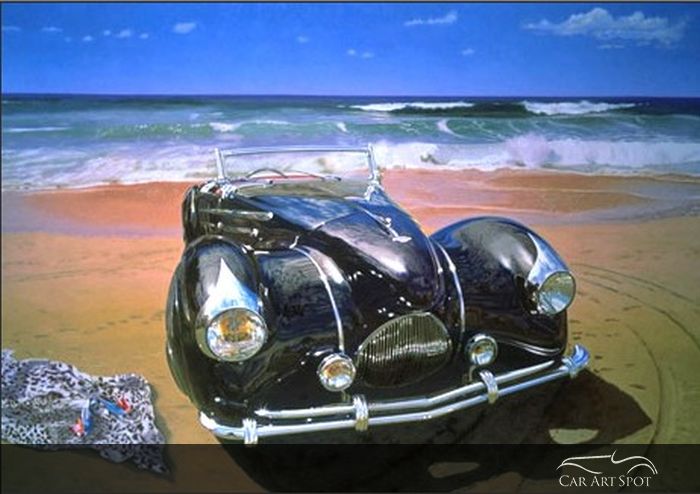
'48 Delahaye on the Beach by AFAS artist Nicola Wood
Do you have advice for automotive artists who are captured in that niche of auto art and who are struggling to identify themselves with their art?
It's really difficult right now. The economy and the way it is. People are not buying. I sell prints off my website and other places. The market has just gone flat like a pancake. This is a tricky one because most of the people starting out today are going to be doing it through their computer digitally.
Not all of them. I know a couple of young guys who really want to do it the traditional way. So not everything is digital.
Oh good because unfortunately a lot of digital type people haven't learned to draw and consequently they haven't learned to 'see' properly. So there is a bit of a disadvantage.
So your advice would be to start practicing the traditional way, getting your drawing techniques right and then move on.
Absolutely, in fact two years ago I went back to school to learn the traditional way of painting because I wasn't taught to paint. I wanted to paint like the old masters and use their techniques. They are very different from the way I paint. My paintings are all neat and tidy and you don't have to stand back to see the detail. It takes a lot of sacrifices for the sake of painting and proving to yourself that you can do it.
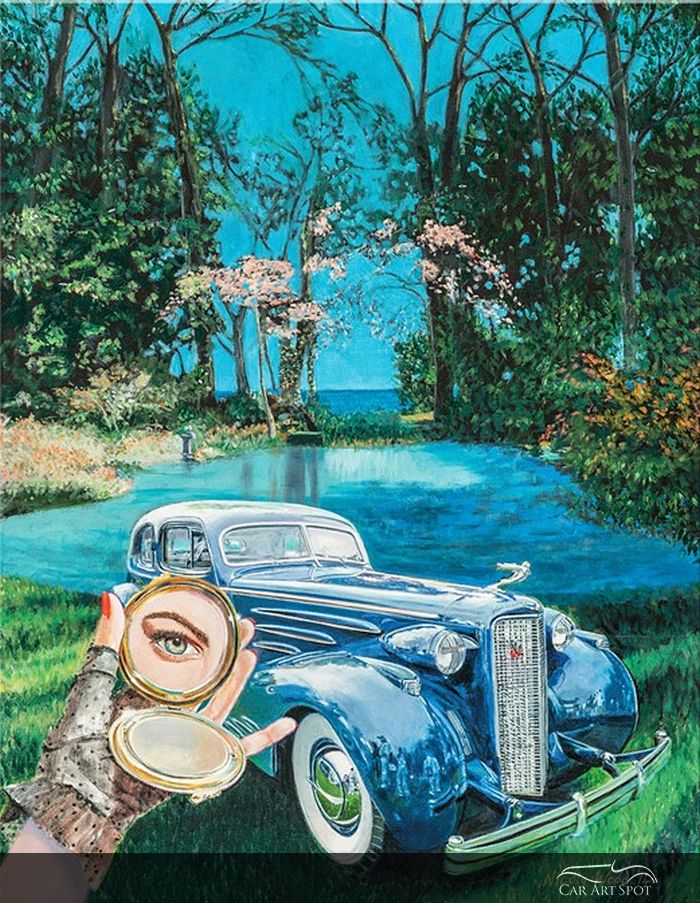
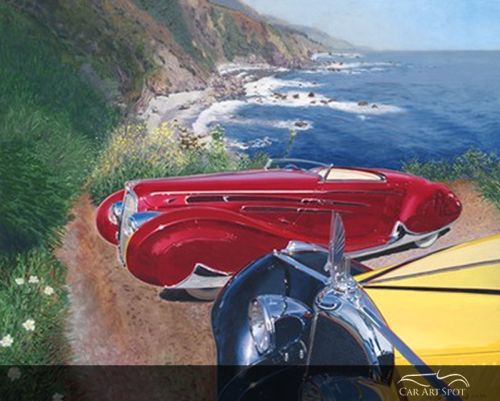
Automotive Fine Art by Nicola Wood
You had this pivotal moment in your life whereby you want to look back and have had achieved something. Are you on track?
I am still on track and still going. I am really glad that I took that gamble years ago. I didn't think for a minute I would end up at Pebble Beach with AFAS. I just thought I would try and find a gallery somewhere but galleries are a niche automotive art. I remember going into one gallery and even though they liked my work, they told me that no-one is going to want to have a painting of a motorcar on their dining room wall. When you go into a mechanic shops, they have pictures of cars with half naked girls standing next to them. So I guess the galleries thought that was the only way to go with automotive art. I have proven them wrong.
I believe automotive art needs to be appreciated by a much larger audience than it is today. I am striving to show the regular art world that automotive art is much more than a nice representation or illustration of a car. It IS art.
I am sure you are already.
Nicola shared with me:
None of this would have happened to me without one man who was a teacher when I was 4 - 10 years old. He obviously saw a little spark in me of some kind. He was my art teacher. I went off to another school. Years later when I was 15, he went to my mother and said 'I have got your daughter an interview at Southwood Academy of Art.
Without that one man making an effort, who I hadn't seen for five years but who remembered me, I would never be where I am today. I am so grateful to him.
Did you have contact with him again?
I didn't. But once during one of my trips back to London, I tried to look him up. I spoke to his wife but he had unfortunately just died. I had wanted to thank him. So I thanked his wife and told her what a difference he had made. He totally changed my whole life and that's what teachers can do.
To see more of Nicola Woods' work, please visit her website.


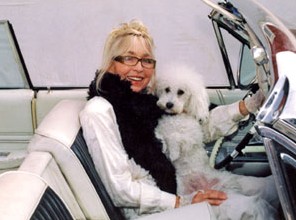
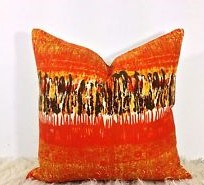
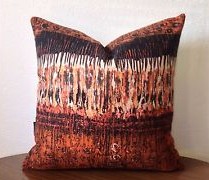
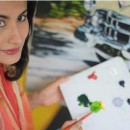
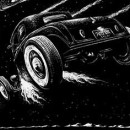
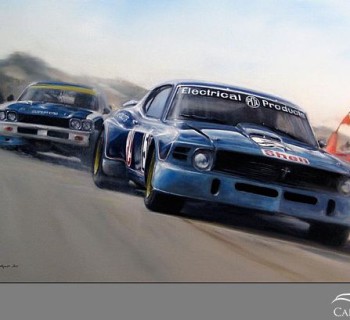

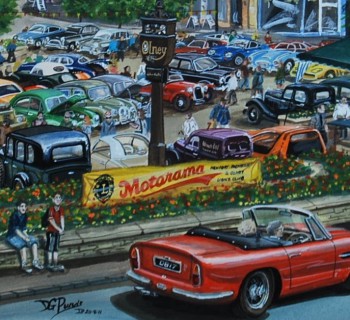
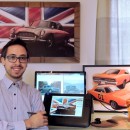




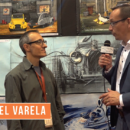
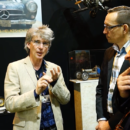
[…] Nicola Wood – JD’s […]
[…] Read our full interview 'Your Life Is What You Notice' with Nicola Wood. […]